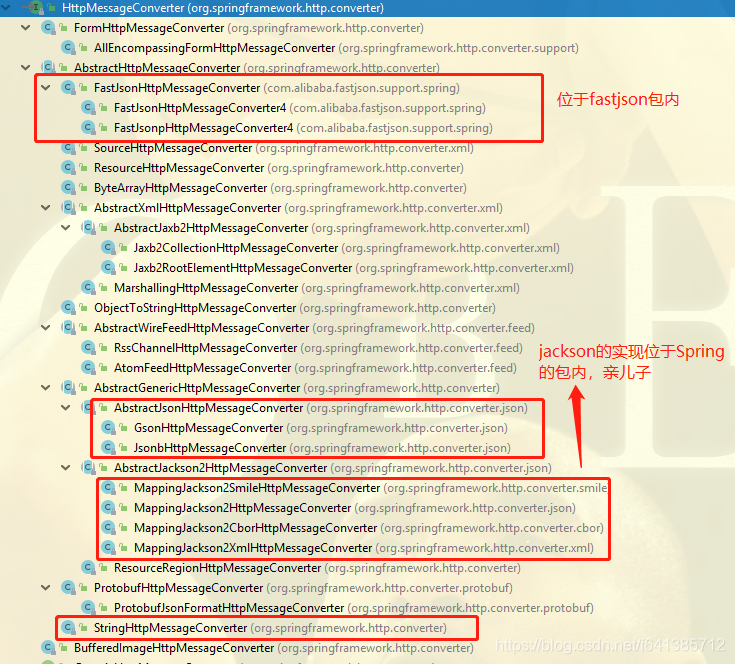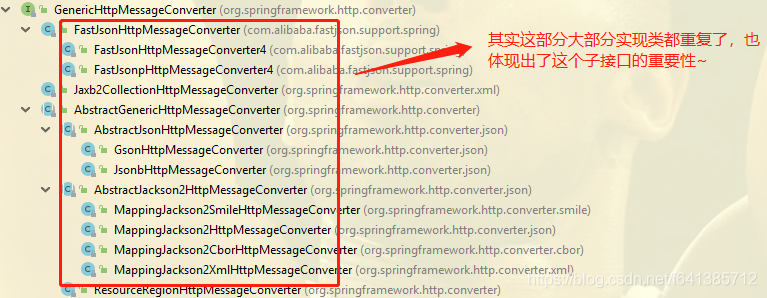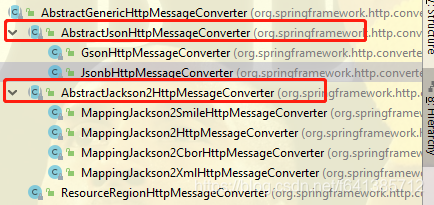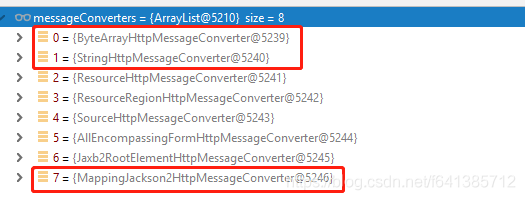Spring MVC九大组件之HandlerAdapter中的消息转换器HttpMessageConverter
本文介绍Spring MVC中的一个极其重要的组件:HttpMessageConverter消息转换器。
有一副非常著名的图,来形容Spring MVC对一个请求的处理:

从图中可见HttpMessageConverter对Spring MVC的重要性。它对请求、响应都起到了非常关键的作用~
为何需要消息转换器
HttpMessageConverter是用来处理request和response里的数据的。
请求和响应都有对应的body,而这个body就是需要关注的主要数据。
请求体的表述一般就是一段字符串,当然也可以是二进制数据(比如上传~)。
响应体则是浏览器渲染页面的依据,对于一个普通html页面得响应,响应体就是这个html页面的源代码。
请求体和响应体都是需要配合Content-Type头部使用的,这个头部主要用于说明body中得字符串是什么格式的,比如:text,json,xml等。对于请求报文,只有通过此头部,服务器才能知道怎么解析请求体中的字符串,对于响应报文,浏览器通过此头部才知道应该怎么渲染响应结果,是直接打印字符串还是根据代码渲染为一个网页。
对于HttpServletRequest和HttpServletResponse,可以分别调用getInputStream和getOutputStream来直接获取body。但是获取到的仅仅只是一段字符串。
而对于java来说,处理一个对象肯定比处理一个字符串要方便得多,也好理解得多。所以根据Content-Type头部,将body字符串转换为java对象是常有的事。反过来,根据Accept头部,将java对象转换为客户端期望格式的字符串也是必不可少的工作。
消息转换器它能屏蔽你对底层转换的实现,分离你的关注点,让你专心操作java对象,其余的事情你就交给我Spring MVC~大大提高你的编码效率(可议说比原生Servlet开发高级太多了)。
Spring内置了很多HttpMessageConverter,比如MappingJackson2HttpMessageConverter,StringHttpMessageConverter,甚至还有FastJsonHttpMessageConverter(需导包和自己配置)。
HttpMessageConverter
在具体讲解之前,先对所有的转换器来个概述:
| 名称 | 作用 | 读支持MediaType | 写支持MediaType | 备注 |
| FormHttpMessageConverter | 表单与MultiValueMap的相互转换 | application/x-www-form-urlencoded | application/x-www-form-urlencoded和multipart/form-data | 可用于处理下载 |
| XmlAwareFormHttpMessageConverter | Spring3.2后已过期,使用下面AllEnc…代替 | 略 | 略 | |
| AllEncompassingFormHttpMessageConverter | 对FormHttp…的扩展,提供了对xml和json的支持 | 同上 | 同上 | |
| SourceHttpMessageConverter | 数据与javax.xml.transform.Source的相互转换 | application/xml和text/xml和application/*+xml | 同read | 和Sax/Dom等有关 |
| ResourceHttpMessageConverter | 数据与org.springframework.core.io.Resource | */* | */* | |
| ByteArrayHttpMessageConverter | 数据与字节数组的相互转换 | */* | application/octet-stream | |
| ObjectToStringHttpMessageConverter | 内部持有一个StringHttpMessageConverter和ConversionService | 它俩的&& | 它俩的&& | |
| RssChannelHttpMessageConverter | 处理RSS <channel> 元素 | application/rss+xml | application/rss+xml | 很少接触 |
| MappingJackson2HttpMessageConverter | 使用Jackson的ObjectMapper转换Json数据 | application/json和application/*+json | application/json和application/*+json | 默认编码UTF-8 |
| MappingJackson2XmlHttpMessageConverter | 使用Jackson的XmlMapper转换XML数据 | application/xml和text/xml | application/xml和text/xml | 需要额外导包Jackson-dataformat-XML才能生效。从Spring4.1后才有 |
| GsonHttpMessageConverter | 使用Gson处理Json数据 | application/json | application/json | 默认编码UTF-8 |
| ResourceRegionHttpMessageConverter | 数据和org.springframework.core.io.support.ResourceRegion的转换 | application/octet-stream | application/octet-stream | Spring4.3才提供此类 |
| ProtobufHttpMessageConverter | 转换com.google.protobuf.Message数据 | application/x-protobuf和text/plain和application/json和application/xml | 同read | @since 4.1 |
| StringHttpMessageConverter | 数据与String类型的相互转换 | */* | */* | 转成字符串的默认编码为ISO-8859-1 |
| BufferedImageHttpMessageConverter | 数据与java.awt.image.BufferedImage的相互转换 | Java I/O API支持的所有类型 | Java I/O API支持的所有类型 | |
| FastJsonHttpMessageConverter | 使用FastJson处理Json数据 | */* | */* | 需要导入Jar包和自己配置,Spring并不默认内置 |
需要知道的是:上面说的支持都说的是默认支持,当然你是可以自定义让他们更强大的。比如:我们可以自己配置StringHttpMessageConverter,改变(增强)它的默认行为:
<mvc:annotation-driven>
<mvc:message-converters>
<bean class="org.springframework.http.converter.StringHttpMessageConverter">
<property name="supportedMediaTypes">
<list>
<value>text/plain;charset=UTF-8</value>
<value>text/html;charset=UTF-8</value>
</list>
</property>
</bean>
</mvc:message-converters>
</mvc:annotation-driven>既然它是HttpMessageConverter,所以铁定和HttpMessage有关,因为此接口涉及的内容相对来说比较偏底层,因此本文只在接口层面做简要的一个说明。
HttpMessage
它是Spring 3.0后增加一个非常抽象的接口。表示:表示HTTP请求和响应消息的基本接口。
public interface HttpMessage {
// Return the headers of this message
HttpHeaders getHeaders();
}看看它的继承树:

HttpInputMessage和HttpOutputMessage
这就是目前都在使用的接口,表示输入、输出信息~
public interface HttpInputMessage extends HttpMessage {
InputStream getBody() throws IOException;
}
public interface HttpOutputMessage extends HttpMessage {
OutputStream getBody() throws IOException;
}HttpRequest
代表着一个Http请求信息,提供了多的几个API,是对HttpMessage的一个补充。Spring3.1新增的
public interface HttpRequest extends HttpMessage {
@Nullable
default HttpMethod getMethod() {
// 可议根据String类型的值 返回一个枚举
return HttpMethod.resolve(getMethodValue());
}
String getMethodValue();
// 可以从请求消息里 拿到URL
URI getURI();
}ReactiveHttpInputMessage和ReactiveHttpOutputMessage
显然,是Spring5.0新增的接口,也是Spring5.0最重磅的升级之一。自此Spring容器就不用强依赖于Servlet容器了。它还可以选择依赖于reactor这个框架。
比如这个类:reactor.core.publisher.Mono就是Reactive的核心类之一~
因为属于Spring5.0的最重要的新特性之一,所以此处也不再过多介绍了。
HttpMessageConverter接口是Spring3.0之后新增的一个接口,它负责将请求信息转换为一个对象(类型为T),并将对象(类型为T)绑定到请求方法的参数中或输出为响应信息
// @since 3.0 Spring3.0后推出的 是个泛型接口
// 策略接口,指定可以从HTTP请求和响应转换为HTTP请求和响应的转换器
public interface HttpMessageConverter<T> {
// 指定转换器可以读取的对象类型,即转换器可将请求信息转换为clazz类型的对象
// 同时支持指定的MIME类型(text/html、application/json等)
boolean canRead(Class<?> clazz, @Nullable MediaType mediaType);
// 指定转换器可以将clazz类型的对象写到响应流当中,响应流支持的媒体类型在mediaType中定义
boolean canWrite(Class<?> clazz, @Nullable MediaType mediaType);
// 返回当前转换器支持的媒体类型~~
List<MediaType> getSupportedMediaTypes();
// 将请求信息转换为T类型的对象 流对象为:HttpInputMessage
T read(Class<? extends T> clazz, HttpInputMessage inputMessage) throws IOException, HttpMessageNotReadableException;
// 将T类型的对象写到响应流当中,同事指定响应的媒体类型为contentType 输出流为:HttpOutputMessage
void write(T t, @Nullable MediaType contentType, HttpOutputMessage outputMessage) throws IOException, HttpMessageNotWritableException;
}看看它的继承树:


按照层级划分,它的直接子类是如下四个:
FormHttpMessageConverter、AbstractHttpMessageConverter、BufferedImageHttpMessageConverter、GenericHttpMessageConverter(Spring3.2出来的,支持到了泛型)。
FormHttpMessageConverter:form表单提交/文件下载
从名字知道,它和Form表单有关。浏览器原生表单默认的提交数据的方式(就是没有设置enctype属性),它默认是这个:Content-Type: application/x-www-form-urlencoded;charset=utf-8
从请求和响应读取/编写表单数据。默认情况下,它读取媒体类型 application/x-www-form-urlencoded 并将数据写入 MultiValueMap<String,String>。因为它独立的存在,所以可以看看源码内容:
// @since 3.0
public class FormHttpMessageConverter implements HttpMessageConverter<MultiValueMap<String, ?>> {
// 默认UTF-8编码 MediaType为:application/x-www-form-urlencoded
public static final Charset DEFAULT_CHARSET = StandardCharsets.UTF_8;
private static final MediaType DEFAULT_FORM_DATA_MEDIA_TYPE = new MediaType(MediaType.APPLICATION_FORM_URLENCODED, DEFAULT_CHARSET);
// 缓存下它所支持的MediaType们
private List<MediaType> supportedMediaTypes = new ArrayList<>();
// 用于二进制内容的消息转换器们~~~ 毕竟此转换器还支持`multipart/form-data`这种 可以进行文件下载~~~~~
private List<HttpMessageConverter<?>> partConverters = new ArrayList<>();
private Charset charset = DEFAULT_CHARSET;
@Nullable
private Charset multipartCharset;
// 唯一的一个构造函数~
public FormHttpMessageConverter() {
// 默认支持处理两种MediaType:application/x-www-form-urlencoded和multipart/form-data
this.supportedMediaTypes.add(MediaType.APPLICATION_FORM_URLENCODED);
this.supportedMediaTypes.add(MediaType.MULTIPART_FORM_DATA);
StringHttpMessageConverter stringHttpMessageConverter = new StringHttpMessageConverter();
stringHttpMessageConverter.setWriteAcceptCharset(false); // see SPR-7316
// === 它自己不仅是个转换器,还内置了这三个转换器 至于他们具体处理那种消息,请看下面 都有详细说明 ==
// 注意:这些消息转换器都是去支持part的,支持文件下载
this.partConverters.add(new ByteArrayHttpMessageConverter());
this.partConverters.add(stringHttpMessageConverter);
this.partConverters.add(new ResourceHttpMessageConverter());
// 这是为partConverters设置默认的编码~~~
applyDefaultCharset();
}
// 省略属性额get/set方法
// 从这可以发现,只有Handler的入参类型是是MultiValueMap它才会去处理~~~~
@Override
public boolean canRead(Class<?> clazz, @Nullable MediaType mediaType) {
if (!MultiValueMap.class.isAssignableFrom(clazz)) {
return false;
}
// 若没指定MedieType 会认为是可读的~
if (mediaType == null) {
return true;
}
// 显然,只有我们Supported的MediaType才会是true(当然multipart/form-data例外,此处是不可读的)
for (MediaType supportedMediaType : getSupportedMediaTypes()) {
// We can't read multipart....
if (!supportedMediaType.equals(MediaType.MULTIPART_FORM_DATA) && supportedMediaType.includes(mediaType)) {
return true;
}
}
return false;
}
// 注意和canRead的区别,有点对着干的意思~~~
@Override
public boolean canWrite(Class<?> clazz, @Nullable MediaType mediaType) {
if (!MultiValueMap.class.isAssignableFrom(clazz)) {
return false;
}
// 如果是ALL 说明支持所有的类型 那就恒返回true 当然null也是的
if (mediaType == null || MediaType.ALL.equals(mediaType)) {
return true;
}
for (MediaType supportedMediaType : getSupportedMediaTypes()) {
// isCompatibleWith是否是兼容的
if (supportedMediaType.isCompatibleWith(mediaType)) {
return true;
}
}
return false;
}
// 把输入信息读进来,成为一个 MultiValueMap<String, String>
// 注意:此处发现class这个变量并没有使用~
@Override
public MultiValueMap<String, String> read(@Nullable Class<? extends MultiValueMap<String, ?>> clazz,
HttpInputMessage inputMessage) throws IOException, HttpMessageNotReadableException {
// 拿到请求的ContentType请求头~~~~
MediaType contentType = inputMessage.getHeaders().getContentType();
// 这里面 编码放在contentType里面 若没有指定 走默认的编码
// 类似这种形式就是我们自己指定了编码:application/json;charset=UTF-8
Charset charset = (contentType != null && contentType.getCharset() != null ? contentType.getCharset() : this.charset);
// 把body的内容读成字符串~
String body = StreamUtils.copyToString(inputMessage.getBody(), charset);
// 用"&"分隔 因为此处body一般都是hello=world&fang=shi这样传进来的
String[] pairs = StringUtils.tokenizeToStringArray(body, "&");
MultiValueMap<String, String> result = new LinkedMultiValueMap<>(pairs.length);
// 这个就不说了,就是把键值对保存在map里面。注意:此处为何用多值Map呢?因为一个key可能是会有多个value的
for (String pair : pairs) {
int idx = pair.indexOf('=');
if (idx == -1) {
result.add(URLDecoder.decode(pair, charset.name()), null);
}
else {
String name = URLDecoder.decode(pair.substring(0, idx), charset.name());
String value = URLDecoder.decode(pair.substring(idx + 1), charset.name());
result.add(name, value);
}
}
return result;
}
}AbstractHttpMessageConverter
一个基础抽象实现,它是个泛型类。对于泛型的控制,有如下特点:
- 最广的可以选择Object,不过Object并不都是可以序列化的,但是子类可以在覆盖supports方法中进一步控制,因此选择Object是可以的
- 最符合的是Serializable,既完美满足泛型定义,本身也是个Java序列化/反序列化的充要条件
- 自定义的基类Bean,有些技术规范要求自己代码中的所有bean都继承自同一个自定义的基类BaseBean,这样可以在Serializable的基础上再进一步控制,满足自己的业务要求
若我们自己需要自定义一个消息转换器,大多数情况下也是继承抽象类再具体实现。比如我们最熟悉的:FastJsonHttpMessageConverter它就是一个子类实现
public abstract class AbstractHttpMessageConverter<T> implements HttpMessageConverter<T> {
// 它主要内部维护了这两个属性,可议构造器赋值,也可以set方法赋值~~
private List<MediaType> supportedMediaTypes = Collections.emptyList();
@Nullable
private Charset defaultCharset;
// supports是个抽象方法,交给子类自己去决定自己支持的转换类型~~~~
// 而canRead(mediaType)表示MediaType也得在我支持的范畴了才行(入参MediaType若没有指定,就返回true的)
@Override
public boolean canRead(Class<?> clazz, @Nullable MediaType mediaType) {
return supports(clazz) && canRead(mediaType);
}
// 原理基本同上,supports和上面是同一个抽象方法 所以我们发现并不能入参处理Map,出餐处理List等等
@Override
public boolean canWrite(Class<?> clazz, @Nullable MediaType mediaType) {
return supports(clazz) && canWrite(mediaType);
}
// 这是Spring的惯用套路:readInternal 虽然什么都没做,但我觉得还是挺有意义的。Spring后期也非常的好扩展了~~~~
@Override
public final T read(Class<? extends T> clazz, HttpInputMessage inputMessage)
throws IOException, HttpMessageNotReadableException {
return readInternal(clazz, inputMessage);
}
// 整体上就write方法做了一些事~~
@Override
public final void write(final T t, @Nullable MediaType contentType, HttpOutputMessage outputMessage)
throws IOException, HttpMessageNotWritableException {
final HttpHeaders headers = outputMessage.getHeaders();
// 设置一个headers.setContentType 和 headers.setContentLength
addDefaultHeaders(headers, t, contentType);
if (outputMessage instanceof StreamingHttpOutputMessage) {
StreamingHttpOutputMessage streamingOutputMessage = (StreamingHttpOutputMessage) outputMessage;
// StreamingHttpOutputMessage增加的setBody()方法,关于它下面会给一个使用案例~~~~
streamingOutputMessage.setBody(outputStream -> writeInternal(t, new HttpOutputMessage() {
// 注意此处复写:返回的是outputStream ,它也是靠我们的writeInternal对它进行写入的~~~~
@Override
public OutputStream getBody() {
return outputStream;
}
@Override
public HttpHeaders getHeaders() {
return headers;
}
}));
}
// 最后它执行了flush,这也就是为何我们自己一般不需要flush的原因
else {
writeInternal(t, outputMessage);
outputMessage.getBody().flush();
}
}
// 三个抽象方法
protected abstract boolean supports(Class<?> clazz);
protected abstract T readInternal(Class<? extends T> clazz, HttpInputMessage inputMessage)
throws IOException, HttpMessageNotReadableException;
protected abstract void writeInternal(T t, HttpOutputMessage outputMessage)
throws IOException, HttpMessageNotWritableException;
}关于StreamingHttpOutputMessage的使用:
表示允许设置流正文的HTTP输出消息,需要注意的是,此类消息通常不支持getBody()访问
// @since 4.0
public interface StreamingHttpOutputMessage extends HttpOutputMessage {
// 设置一个流的正文,提供回调
void setBody(Body body);
// 定义可直接写入@link outputstream的主体的协定。
// 通过回调机制间接的访问HttpClient库很有作用
@FunctionalInterface
interface Body {
// 把当前的这个body写进给定的OutputStream
void writeTo(OutputStream outputStream) throws IOException;
}
}SourceHttpMessageConverter
处理一些和xml相关的资源,比如DOMSource、SAXSource、SAXSource等等。
ResourceHttpMessageConverter
负责读取资源文件和写出资源文件数据
它来处理把Resource进行写出去。当然它也可以把body的内容写进到Resource里来。
public class ResourceHttpMessageConverter extends AbstractHttpMessageConverter<Resource> {
// 是否支持读取流信息
private final boolean supportsReadStreaming;
// 默认支持所有的MediaType~~~~~ 但是它有个类型匹配,所以值匹配入参/返回类型是Resource类型的
public ResourceHttpMessageConverter() {
super(MediaType.ALL);
this.supportsReadStreaming = true;
}
@Override
protected boolean supports(Class<?> clazz) {
return Resource.class.isAssignableFrom(clazz);
}
// 直观感受:读的时候也只支持InputStreamResource和ByteArrayResource这两种resource的直接封装
@Override
protected Resource readInternal(Class<? extends Resource> clazz, HttpInputMessage inputMessage)
throws IOException, HttpMessageNotReadableException {
if (this.supportsReadStreaming && InputStreamResource.class == clazz) {
return new InputStreamResource(inputMessage.getBody()) {
@Override
public String getFilename() {
return inputMessage.getHeaders().getContentDisposition().getFilename();
}
};
}
// 若入参类型是Resource接口,也是当作ByteArrayResource处理的
else if (Resource.class == clazz || ByteArrayResource.class.isAssignableFrom(clazz)) {
// 把inputSteeam转换为byte[]数组~~~~~~
byte[] body = StreamUtils.copyToByteArray(inputMessage.getBody());
return new ByteArrayResource(body) {
@Override
@Nullable
public String getFilename() {
return inputMessage.getHeaders().getContentDisposition().getFilename();
}
};
}
else {
throw new HttpMessageNotReadableException("Unsupported resource class: " + clazz, inputMessage);
}
}
@Override
protected void writeInternal(Resource resource, HttpOutputMessage outputMessage)
throws IOException, HttpMessageNotWritableException {
writeContent(resource, outputMessage);
}
// 写也非常的简单,就是把resource这个资源的内容写到body里面去,此处使用的StreamUtils.copy这个工具方法,专门处理流
// 看到此处我们自己并不需要flush,但是需要自己关闭流
protected void writeContent(Resource resource, HttpOutputMessage outputMessage)
throws IOException, HttpMessageNotWritableException {
try {
InputStream in = resource.getInputStream();
try {
StreamUtils.copy(in, outputMessage.getBody());
}
catch (NullPointerException ex) {
// ignore, see SPR-13620
}
finally {
try {
in.close();
}
catch (Throwable ex) {
// ignore, see SPR-12999
}
}
}
catch (FileNotFoundException ex) {
// ignore, see SPR-12999
}
}
}使用它模拟完成上传功能
上传表单如下:
<!DOCTYPE html>
<html lang="en">
<head>
<meta charset="UTF-8">
<title>测试FormHttpMessageConverter</title>
</head>
<body>
<!-- 表单的enctype一定要标注成multipart形式,否则是拿不到二进制流的 -->
<form action="http://localhost:8080/upload" method="post" enctype="multipart/form-data">
用户名 <input type="text" name="userName">
头像 <input type="file" name="touxiang">
<input type="submit">
</form>
</body>
</html>// 模拟使用Resource进行文件的上传~~~
@ResponseBody
@RequestMapping(value = "/upload", method = RequestMethod.POST)
public String upload(@RequestBody Resource resource) { //此处不能用接口Resource resource
dumpStream(resource);
return "success";
}
// 模拟写文件的操作(此处写到控制台)
private static void dumpStream(Resource resource) {
InputStream is = null;
try {
//1.获取文件资源
is = resource.getInputStream();
//2.读取资源
byte[] descBytes = new byte[is.available()];
is.read(descBytes);
System.out.println(new String(descBytes, StandardCharsets.UTF_8));
} catch (IOException e) {
e.printStackTrace();
} finally {
try {
//3.关闭资源
is.close();
} catch (IOException e) {
}
}
}控制台结果为:

由此可见利用它是可以把客户端的资源信息都拿到的,从而间接的实现文件的上传的功能。
ByteArrayHttpMessageConverter
和上面类似。
ObjectToStringHttpMessageConverter
它是对StringHttpMessageConverter的一个扩展。它在Spring内部并没有装配进去。若我们需要,可以自己装配到Spring MVC里面去
public class ObjectToStringHttpMessageConverter extends AbstractHttpMessageConverter<Object> {
// 我们只需要自定定义这个转换器 让它实现String到Obj之间的互相转换~~~
private final ConversionService conversionService;
private final StringHttpMessageConverter stringHttpMessageConverter;
... // 下面省略
// 读的时候先用stringHttpMessageConverter读成String,再用转换器转为Object对象
// 写的时候先用转换器转成String,再用stringHttpMessageConverter写进返回的body里
}Json相关转换器

可以看到一个是谷歌阵营,一个是jackson阵营。
GsonHttpMessageConverter
利用谷歌的Gson进行json序列化的处理~~~
// @since 4.1 可见它被Spring选中的时间还是比较晚的
public class GsonHttpMessageConverter extends AbstractJsonHttpMessageConverter {
private Gson gson;
public GsonHttpMessageConverter() {
this.gson = new Gson();
}
// @since 5.0 调用者可以自己指定一个Gson对象了
public GsonHttpMessageConverter(Gson gson) {
Assert.notNull(gson, "A Gson instance is required");
this.gson = gson;
}
// 因为肯定是文本,所以这里使用Reader 没有啥问题
// 父类默认用UTF-8把inputStream转为了更友好的Reader
@Override
protected Object readInternal(Type resolvedType, Reader reader) throws Exception {
return getGson().fromJson(reader, resolvedType);
}
@Override
protected void writeInternal(Object o, @Nullable Type type, Writer writer) throws Exception {
// 如果带泛型 这里也是特别的处理了兼容处理~~~~
if (type instanceof ParameterizedType) {
getGson().toJson(o, type, writer);
} else {
getGson().toJson(o, writer);
}
}
// 父类定义了它支持的MediaType类型~
public AbstractJsonHttpMessageConverter() {
super(MediaType.APPLICATION_JSON, new MediaType("application", "*+json"));
setDefaultCharset(DEFAULT_CHARSET);
}
}MappingJackson2HttpMessageConverter
利用Jackson进行json序列化
// @since 3.1.2 出来可谓最早。正统太子
public class MappingJackson2HttpMessageConverter extends AbstractJackson2HttpMessageConverter {
// 该属性在父类定义~~~
protected ObjectMapper objectMapper;
@Nullable
private String jsonPrefix;
// 支持指定的MediaType类型~~
public MappingJackson2HttpMessageConverter(ObjectMapper objectMapper) {
super(objectMapper, MediaType.APPLICATION_JSON, new MediaType("application", "*+json"));
}
// 所有的读、写都在父类AbstractJackson2HttpMessageConverter里统一实现的,稍微有点复杂性
}若你的返回值是Map、List等,只要MediaType对上了,这种json处理器都是可以处理的。因为他们泛型上都是Object表示入参、 返回值任意类型都可以处理~~~
StringHttpMessageConverter
这个是使用得非常广泛的一个消息转换器,专门处理入参/出参字符串类型。
// @since 3.0 出生非常早
public class StringHttpMessageConverter extends AbstractHttpMessageConverter<String> {
// 这就是为何你return中文的时候会乱码的原因(若你不设置它的编码的话~)
public static final Charset DEFAULT_CHARSET = StandardCharsets.ISO_8859_1;
@Nullable
private volatile List<Charset> availableCharsets;
// 标识是否输出 Response Headers:Accept-Charset(默认true表示输出)
private boolean writeAcceptCharset = true;
public StringHttpMessageConverter() {
this(DEFAULT_CHARSET);
}
public StringHttpMessageConverter(Charset defaultCharset) {
super(defaultCharset, MediaType.TEXT_PLAIN, MediaType.ALL);
}
//Indicates whether the {@code Accept-Charset} should be written to any outgoing request.
// Default is {@code true}.
public void setWriteAcceptCharset(boolean writeAcceptCharset) {
this.writeAcceptCharset = writeAcceptCharset;
}
// 只处理String类型~
@Override
public boolean supports(Class<?> clazz) {
return String.class == clazz;
}
@Override
protected String readInternal(Class<? extends String> clazz, HttpInputMessage inputMessage) throws IOException {
// 哪编码的原则为:
// 1、contentType自己指定了编码就以指定的为准
// 2、没指定,但是类型是`application/json`,统一按照UTF_8处理
// 3、否则使用默认编码:getDefaultCharset ISO_8859_1
Charset charset = getContentTypeCharset(inputMessage.getHeaders().getContentType());
// 按照此编码,转换为字符串~~~
return StreamUtils.copyToString(inputMessage.getBody(), charset);
}
// 显然,ContentLength和编码也是有关的~~~
@Override
protected Long getContentLength(String str, @Nullable MediaType contentType) {
Charset charset = getContentTypeCharset(contentType);
return (long) str.getBytes(charset).length;
}
@Override
protected void writeInternal(String str, HttpOutputMessage outputMessage) throws IOException {
// 默认会给请求设置一个接收的编码格式~~~(若用户不指定,是所有的编码都支持的)
if (this.writeAcceptCharset) {
outputMessage.getHeaders().setAcceptCharset(getAcceptedCharsets());
}
// 根据编码把字符串写进去~
Charset charset = getContentTypeCharset(outputMessage.getHeaders().getContentType());
StreamUtils.copy(str, charset, outputMessage.getBody());
}
...
}我们也可以这么来写,达到我们一定的目的:
// 因为它支持MediaType.TEXT_PLAIN, MediaType.ALL所有类型,所以你的contentType无所谓~~~ 它都能够处理
@ResponseBody
@RequestMapping(value = "/test", method = RequestMethod.POST)
public String upload(@RequestBody String body) {
return "Hello World";
}这种书写方式它不管是入参,还是返回值处理的转换器,都是用到的StringHttpMessageConverter。用它来接收入参和上面例子Resource有点像,只是StringHttpMessageConverter它只能解析文本内容,而Resource可以处理所有。
需要注意的是:若你的项目中大量使用到了此转换器,请一定要注意编码问题。一般不建议直接使用StringHttpMessageConverter,而是我们配置好编码(UTF-8)后,再把它加入到Spring MVC里面,这样就不会有乱码问题了
BufferedImageHttpMessageConverter
处理java.awt.image.BufferedImage,和awt相关。
GenericHttpMessageConverter 子接口
GenericHttpMessageConverter接口继承自HttpMessageConverter接口,二者都是在org.springframework.http.converter包下。它的特点就是:它处理目标类型为泛型类型的类型~~~
public interface GenericHttpMessageConverter<T> extends HttpMessageConverter<T> {
//This method should perform the same checks than {@link HttpMessageConverter#canRead(Class, MediaType)} with additional ones related to the generic type.
// 它的效果同父接口的canRead,但是它是加了一个泛型类型~~~来加以更加详细的判断
boolean canRead(Type type, @Nullable Class<?> contextClass, @Nullable MediaType mediaType);
// 一样也是加了泛型类型
T read(Type type, @Nullable Class<?> contextClass, HttpInputMessage inputMessage)
throws IOException, HttpMessageNotReadableException;
//@since 4.2
boolean canWrite(@Nullable Type type, Class<?> clazz, @Nullable MediaType mediaType);
// @since 4.2
void write(T t, @Nullable Type type, @Nullable MediaType contentType, HttpOutputMessage outputMessage) throws IOException, HttpMessageNotWritableException;
}
可以看出处理Json方面的转换器,都实现了此接口。此处主要以阿里巴巴的FastJson转换器为例加以说明:
FastJsonHttpMessageConverter
// Fastjson for Spring MVC Converter. Compatible Spring MVC version 3.2+
// @since 1.2.10
public class FastJsonHttpMessageConverter extends AbstractHttpMessageConverter<Object>
implements GenericHttpMessageConverter<Object> {
public FastJsonHttpMessageConverter() {
super(MediaType.ALL);
}
// 永远返回true,表示它想支持所有的类型,所有的MediaType,现在这算一个小Bug
@Override
protected boolean supports(Class<?> clazz) {
return true;
}
// 它竟然对泛型Type都没有任何的实现,这也是一个小bug
// 包括读写的时候 对泛型类型都没有做很好的处理~~~
public boolean canRead(Type type, Class<?> contextClass, MediaType mediaType) {
return super.canRead(contextClass, mediaType);
}
public boolean canWrite(Type type, Class<?> clazz, MediaType mediaType) {
return super.canWrite(clazz, mediaType);
}
// 这是处理读的方法,主要依赖于JSON.parseObject这个方法解析成一个object
private Object readType(Type type, HttpInputMessage inputMessage) {
try {
InputStream in = inputMessage.getBody();
return JSON.parseObject(in,
fastJsonConfig.getCharset(),
type,
fastJsonConfig.getParserConfig(),
fastJsonConfig.getParseProcess(),
JSON.DEFAULT_PARSER_FEATURE,
fastJsonConfig.getFeatures());
} catch (JSONException ex) {
throw new HttpMessageNotReadableException("JSON parse error: " + ex.getMessage(), ex);
} catch (IOException ex) {
throw new HttpMessageNotReadableException("I/O error while reading input message", ex);
}
}
}总体来说,如果你是FastJson的死忠粉,你可以替换掉默认的Jackson的实现方式。但是由于FastJson在效率在对标Jackson并没有多少优势,所以绝大多数情况下,我并不建议修改Spring MVC处理json的默认行为。
ResourceRegionHttpMessageConverter
和org.springframework.core.io.support.ResourceRegion有关,它只能写为一个ResourceRegion或者一个它的List
只能写不能读,读方法都会抛异常~
// 这个类很简单,就是对Resource的一个包装 所以它和`application/octet-stream`也是有关的
// @since 4.3
public class ResourceRegion {
private final Resource resource;
private final long position;
private final long count;
...
}若你报错说ResourceRegionHttpMessageConverter类找不到,请检查你的Spring版本。因此此类@since 4.3
自定义消息转换器PropertiesHttpMessageConverter处理Properties类型数据
自定义的主要目的是加深对消息转换器的理解。此处我们仍然是通过继承AbstractHttpMessageConverter方式来扩展:
public class PropertiesHttpMessageConverter extends AbstractHttpMessageConverter<User> {
// 用于仅仅只处理我自己自定义的指定的MediaType
private static final MediaType DEFAULT_MEDIATYPE = MediaType.valueOf("application/properties");
public PropertiesHttpMessageConverter() {
super(DEFAULT_MEDIATYPE);
setDefaultCharset(StandardCharsets.UTF_8);
}
// 要求入参、返回值必须是User类型我才处理
@Override
protected boolean supports(Class<?> clazz) {
return clazz.isAssignableFrom(User.class);
}
@Override
protected User readInternal(Class<? extends User> clazz, HttpInputMessage inputMessage) throws IOException, HttpMessageNotReadableException {
InputStream is = inputMessage.getBody();
Properties props = new Properties();
props.load(is);
// user的三个属性
String id = props.getProperty("id");
String name = props.getProperty("name");
String age = props.getProperty("age");
return new User(Integer.valueOf(id), name, Integer.valueOf(age));
}
@Override
protected void writeInternal(User user, HttpOutputMessage outputMessage) throws IOException, HttpMessageNotWritableException {
OutputStream os = outputMessage.getBody();
Properties properties = new Properties();
// 属性判空此处我就不做了~~~
properties.setProperty("id", user.getId().toString());
properties.setProperty("name", user.getName());
properties.setProperty("age", user.getAge().toString());
properties.store(os, "user comments");
}
}其实发现,处理代码并不多。需要注意的是:此处我们只处理我们自定义的:application/properties-user这一种MediaType即可,职责范围放到最小。
接下来就是要注册进Spring MVC里:
@Configuration
@EnableWebMvc
public class WebMvcConfig extends WebMvcConfigurerAdapter {
@Override
public void extendMessageConverters(List<HttpMessageConverter<?>> converters) {
// 因为此转换器职责已经足够单一,所以放在首位是木有问题的~
converters.add(0, new PropertiesHttpMessageConverter());
// 若放在末尾,将可能不会生效~~~~(比如如果Fastjson转换器 处理所有的类型的话,所以放在首位最为保险)
//converters.add(0, new PropertiesHttpMessageConverter());
}
}这里需要注意的是,为了避免意外,一定要注意自定义消息转换器的注册顺序问题。
编写Handler处理器如下:
@ResponseBody
@RequestMapping(value = "/test/properties", method = RequestMethod.POST)
public User upload(@RequestBody User user) {
System.out.println(user);
return user;
}Spring MVC默认注册哪些HttpMessageConverter
说明:此处情况完全以Spring MVC版本讲解,和Spring Boot无关。
Spring 版本号为:5.1.6.RELEASE
- 不开启该注解:@EnableWebMvc

- 开启该注解:@EnableWebMvc

可以看到@EnableWebMvc注解的“威力”还是蛮大的,一下子让Spring MVC变强不少,所以一般情况下,我是建议开启它的。
在纯Spring环境下,我是无理由建议标注@EnableWebMvc上此注解的。
而且从上面可以看出,若我们classpath下有Jackson的包,那装配的就是MappingJackson2HttpMessageConverter,若没有jackson包有gson包,那装配的就是gson转换器。
小细节
- 如果一个Controller类里面所有方法的返回值都需要经过消息转换器,那么可以在类上面加上@ResponseBody注解或者将@Controller注解修改为@RestController注解,这样做就相当于在每个方法都加上了@ResponseBody注解了(言外之意别的方式都是不会经历消息转换器的)
- @ResponseBody和@RequestBody都可以处理Map类型的对象。如果不确定参数的具体字段,可以用Map接收。@ReqeustBody同样适用。(List也是木有问题的)
- 方法上的和类上的@ResponseBody都可以被继承
- 默认的xml转换器Jaxb2RootElementHttpMessageConverter需要类上有@XmlRootElement注解才能被转换(虽然很少使用但此处还是指出)
@Override
public boolean canWrite(Class<?> clazz, MediaType mediaType) {
return (AnnotationUtils.findAnnotation(clazz, XmlRootElement.class) != null && canWrite(mediaType));
}- 返回值类型可声明为基类的类型,不影响转换(比如我们返回值是Object都是木有关系的)。但参数的类型必需为特定的类型(最好不要用接口类型,当然有的时候也是可以的比如Map/List/Resource等等)。这是显而易见的
总结
请求和响应都有对应的body,而这个body就是需要关注的主要数据。
请求体与请求的查询参数或者表单参数是不同的:
请求体的表述一般就是一段字符串(当然也可能是二进制),而查询参数可以看作url的一部分,这两个是位于请求报文的不同地方。表单参数可以按照一定格式放在请求体中,也可以放在url上作为查询参数。
响应体则是浏览器渲染页面的依据,对于一个普通html页面得响应,响应体就是这个html页面的源代码。请求体和响应体都是需要配合Content-Type头部使用的,这个头部主要用于说明body中得字符串是什么格式的,比如:text,json,xml等。
- 对于请求报文,只有通过此头部,服务器才能知道怎么解析请求体中的字符串
- 对于响应报文,浏览器通过此头部才知道应该怎么渲染响应结果,是直接打印字符串还是根据代码渲染为一个网页
还有一个与body有关的头部是Accept,这个头部标识了客户端期望得到什么格式的响应体。服务器可根据此字段选择合适的结果表述。
对于HttpServletRequest和HttpServletResponse,可以分别调用getInputStream和getOutputStream来直接获取body,但是获取到的仅仅只是一段字符串。
而对于Java来说,处理一个对象肯定比处理一个字符串要方便得多,也好理解得多。
所以根据Content-Type头部,将body字符串转换为java对象是常有的事。反过来,根据Accept头部,将java对象转换客户端期望格式的字符串也是必不可少的工作。



【推荐】国内首个AI IDE,深度理解中文开发场景,立即下载体验Trae
【推荐】编程新体验,更懂你的AI,立即体验豆包MarsCode编程助手
【推荐】抖音旗下AI助手豆包,你的智能百科全书,全免费不限次数
【推荐】轻量又高性能的 SSH 工具 IShell:AI 加持,快人一步
· go语言实现终端里的倒计时
· 如何编写易于单元测试的代码
· 10年+ .NET Coder 心语,封装的思维:从隐藏、稳定开始理解其本质意义
· .NET Core 中如何实现缓存的预热?
· 从 HTTP 原因短语缺失研究 HTTP/2 和 HTTP/3 的设计差异
· 使用C#创建一个MCP客户端
· 分享一个免费、快速、无限量使用的满血 DeepSeek R1 模型,支持深度思考和联网搜索!
· ollama系列1:轻松3步本地部署deepseek,普通电脑可用
· 基于 Docker 搭建 FRP 内网穿透开源项目(很简单哒)
· 按钮权限的设计及实现